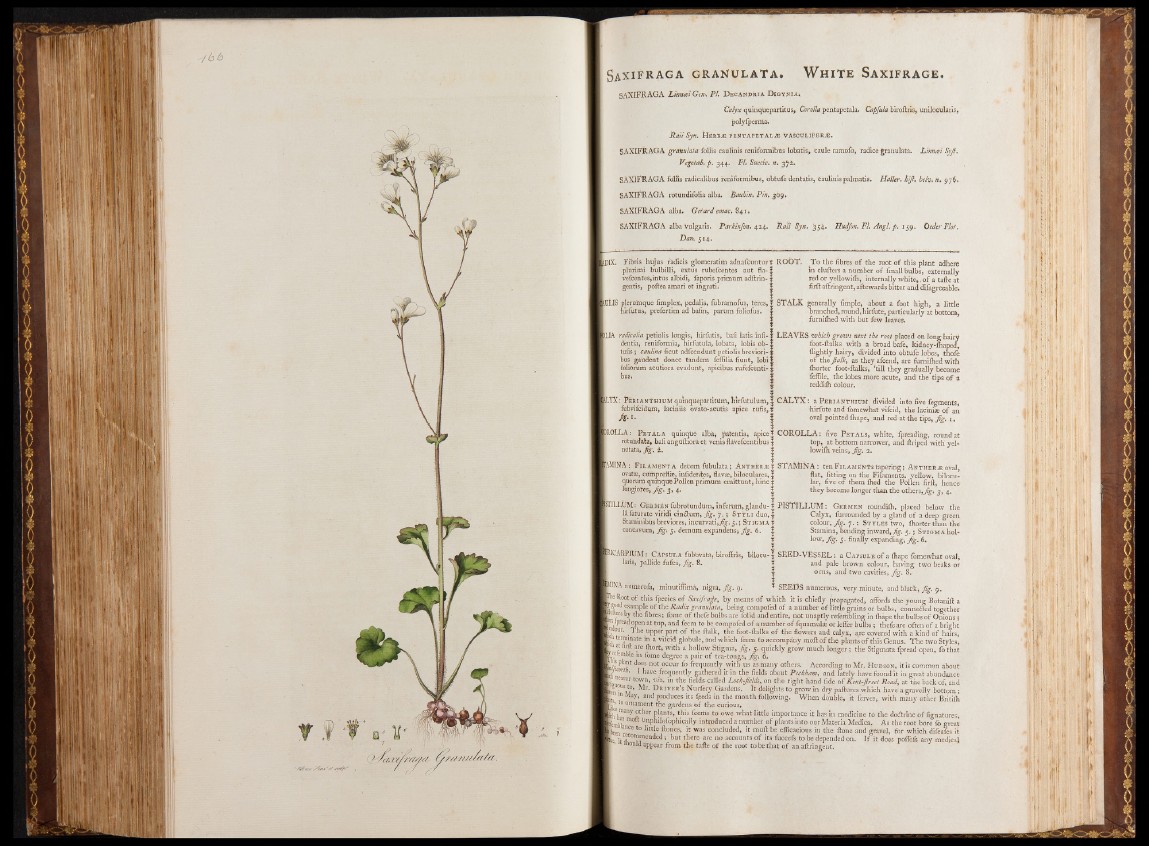
SAXIFRAGA Lintuei Gern PI. Decandria Digynia*
Calyx quînqüepartitus, Corolla pentapetala. Capfula biroftris, unilocularis,
polyfperaia.
ÎZaii Syn. Ôërbæ pentapetAlæ v a Sculifer®.
SAXIFRAGA granulata foliis caulinis reniformibüs lobatis, taüle ramofo* radice granulata. Limai Syß.
Vegetab. p. 344. Fl. Sitecic. n. 372.
SAXIFRAGA föllis radicalibus reniformibüs, öbtufe dentätis, caulinis palmatis. Haller, hijh helv. ». 97$.
SAXIFRAGA rötundifolia alba. Bauhin. Pin. 309.
SAXIFRÀGA alba. Gepard imac, 841»
SAXIFRAGA alba Vulgaris. Parkinfon. 424* jfiSjP Syn. 354* Hüdfon. Fl. Angl. p. 159. Oet)er Plot.
Han. 514.
DIX. Fibris hujus rkdicis glomeratirh plurimi bulbilli, extus rubefcentaeds naafuctu nftlua-r gveefncteisn,t esp*oifnttfUias a atalbairdi ie, t fhapigorraist i:primum adftrin-
(ULIS hpilrefruut tuosq, uper efifmerptliemx ,a pde bdaafliihs,, fpuabrruammo ffoulsio, ftuesf.es,
LIA rdaednictaiali,a rpeentiifoolrism liöan, ghisir, fuhtiurlfau,t ilso,b abtaaf,i llaotbisis i nofbi-- tbuufsi s g; acuaduelinnta dfiocnuete a dtafcnednedmu ntf epfelitliioäl iHs ubnret,v iloorbi-i fboulsi*orum acutiora evadunt, apicibus rüfefcènti-
ROOT. iTn oc ltuhfete rfsib ar ens uomf btehre orfo ofmt oafll tbhuilsb ps,l aenxt teardnhaelrlye freirdf to arf tyreinllgoewnitf, ha,f teinwtaerrdnsa lbliyt twerh aitned* .doiffa ag rteaefateb laet.
STALK gbernaenrcahlleyd , friomupnlde,, h iarfbuotuet, paa rftoicout lahrilgyh a,t bao tltiottmle, furnifhed with but few leaves.
LEAVES fwoohti-cfhta glkrso |w ws inthe xta t hber oraodot bpalfaec,e dk iodnn eloyn-fgh ahpaeirdy, folfig thhtely fi ahalkir,y *a s dtihveidye adf einentod , oabrteu ffeu rlnobifehse*d twhoitfhe ffehfofriltee,r tfhoeo lto-fbteaslk ms,o r‘tei lal ctuhteey, garnadd uthaell yt ibpesc oofm ae reddifh colour.
CALVX: a Perianthium divided into five fegments*
'hirfute and fomewhat vifeid, the laciniae of an
oval pointed fhape, and red at the tips, Jig. 1.
COROLLA: five Petals, white* fpreading, round at
top, at bottom narrower* and ftriped with yellowifh
veins, fig. 2.
STAMINfAla:t , tefnit tFinilga omn etnhet sF tialpamereinngts;, Ayneltlohwe,r .b®i loovcaul*
ltahre,y fbiveec oomf et hloenmg efrh tehda nth teh e Poothlleerns, ./fgir-f*t* 3 ,h e4n.ce
ILYX: PërïanTHi.utó quinqüepartltüm* hirfutülum,
lubvifeidum* laciniis ovato-acutis apice rufis,
m *•
ROLLroAt:u ndPaetat,A bla fai anqguUinfqtiUorea eatlb vae*n tsp afltaeVhteiafc*e natpibicues notata, fig. i.
JAMINoAv :a hFe,i lcoaihmperenftla ae, idneffidceemhf cAesi,b fulalavtaae;, bAilonctuhlaerres®, lqounogriuomfe sq,u fiihgq. u3e, P4o.llen primum emittunt* hinc
STILLlÜaMfa:t uGtaeter mviarind if ucbinro&tuunmd,U fimg,. i7h.f5e tUtti, giandü-f PlSTILLUM: GeRMen roundifh, placed below the Staminibus breviores* incurvati, St Vli duo, I Calyx, fürrouuded by a gland of a deep green coneavum, fig. 5. j Stigma f colour, fig. 7.: Styles two, fhorter than the fig-. 5. detoum expandehs* fig. 6. * | Slotawm, ina, bending inward, fig. 5.5 Stigma hol- fig. 5. finally expanding, fig. 6.
toRPlaIriÜs* Mpa:l liCdAe pfsuüfclaa, ffigub. b8v.a ta* biroftris* bllocu- % |S ËED-VËanSdS EpLal:e ab rCoawpns ucloel ooufr a, fhhaavpien gf omtweow bheaat kosv aolr* I orns* and two cavities* fig. 8.
P A nilmerbfa, minutiftirtia, nigra, fig. 9; * SEEDS numerous, very toiriute, and black* fig. 9.
Ir 1g6o Rddo eoxt aomf ptlhei so ff pthecei eRsa odfix S garxaifnrualgaeta, , bbye minega cnos mdpfo wfehdi bohf ai tn iusm chbieerf loyf plirtotlpea ggraateinds, oaff fbourdlbs st,h ec oynonuencgte dB ototagneitfhte ar I• Rut tieprfse ad tobpee n" barte s 5 fome: of, thefe bulbs are folid and entire* not unaptly refembling in fhape the bulbs of Onions; ioiout-. The upptoepr ,p aanrdt olefe tmh et of tbael kc,o mthpeo ffeodo to-fft aa lnkus mobf etrh oef f floqwuaemrs uatned o cf alelyffxe,r baruel bcso;v etrheedf ew airteh oaf tkeinn do fo af bhraigirhs;t
ISc hJ rt i fuf ®S 1?11 0a1 Vt’ ilwci.idt hS lao bbuoIlelo>wan dS twighm5cah, ffiege.m 5 .t oq uacicckolmy pgarnoyw m mouftc ohf ltohneg pelra;n ttsh oe fS tthigism Gaetan ufpsr. eaTdh oep tewno, Sfoty tlheas*t I eietnbte in fome degree a pair of tea-tongs, figi 6. t t is plant does not occur fo frequently with us as many others. According to Mr. Hudson* it is common about nert^ ’e r.*t ob^av ew sfsr.e iq„u ethnetl yfi egladtsh cearlelded i t in the fields about Peckham, and lately have found it in great abundance rers D Lock-fields, on the tight hand fide of Kent-fireet Road, at the back of, and , n May, and prroivduecre ss iNtsu frefeodrys iGn atrhdée nms.o ntIht fdoellliogwhtisn gto. grWowh einn ddroyu bplaef,t uifte sf ewrvheisc*h whaivthe ma garnayv eoltlhye br oBttroitmifh; gHieke m° aonryn aomtheenrt ptlbaen tgsa, rtdheinss f oeefr ttihs eto c uorwioeu ws.hat little importance it has in medicine to the doftrine of fignatures,
fKeemebnl a t0■ h ^phdoftfoonpehsi» cai£l lyw ainst rCoodnuccleudd ead n, uimt mbeurf ot fb ep leafnfitcsa icnitoou so uinr Mthaet efrtioan Me eadnidc ag. ravAels, tfhoer rowoht icbho rde iffeoa gferse aitt e1 it ,n°ula appear frboumt tthheer eta fatree oHf t haceo roouontt st oo bf ei ttsh aftu cocfe fasn t oa fbtrei ndgeepnent.ded on. If it does poftefs. any medical